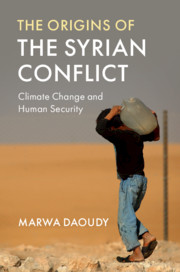Book contents
- The Origins of the Syrian Conflict
- The Origins of the Syrian Conflict
- Copyright page
- Contents
- Figures
- Tables
- Acknowledgements and Preface
- I The Context
- 1 Climate Change and the Syrian Revolution
- 2 The Many Faces of Environmental Security
- 3 When Geography Rules History
- II Human–Environmental–Climate Security (HECS)
- References
- Index
2 - The Many Faces of Environmental Security
from I - The Context
Published online by Cambridge University Press: 05 March 2020
- The Origins of the Syrian Conflict
- The Origins of the Syrian Conflict
- Copyright page
- Contents
- Figures
- Tables
- Acknowledgements and Preface
- I The Context
- 1 Climate Change and the Syrian Revolution
- 2 The Many Faces of Environmental Security
- 3 When Geography Rules History
- II Human–Environmental–Climate Security (HECS)
- References
- Index
Summary
Chapter 2 explores the securitization of climate change by engaging with the scholarly debate around environmental and climate security, human security, water and food security, and climate-induced migration. The chapter traces the broadening of traditional security studies to include non-Western perspectives and a more diverse array of potential threats, including environmental degradation, poverty, water scarcity, and climate change. This theoretical review provides the foundation for the discussion of a potential climate-food insecurity and migration nexus. The author shows that the literature has not conclusively shown linkages between climate change, food insecurity, migration and conflict – either globally or in Syria – but that the HECS framework can be used to rigorously evaluate the interactions between these variables. A key theme of this chapter is the need to recognize and prioritize non-Western and marginalized perspectives and agency in environmental security and migration discourses.
Keywords
- Type
- Chapter
- Information
- The Origins of the Syrian ConflictClimate Change and Human Security, pp. 24 - 76Publisher: Cambridge University PressPrint publication year: 2020

